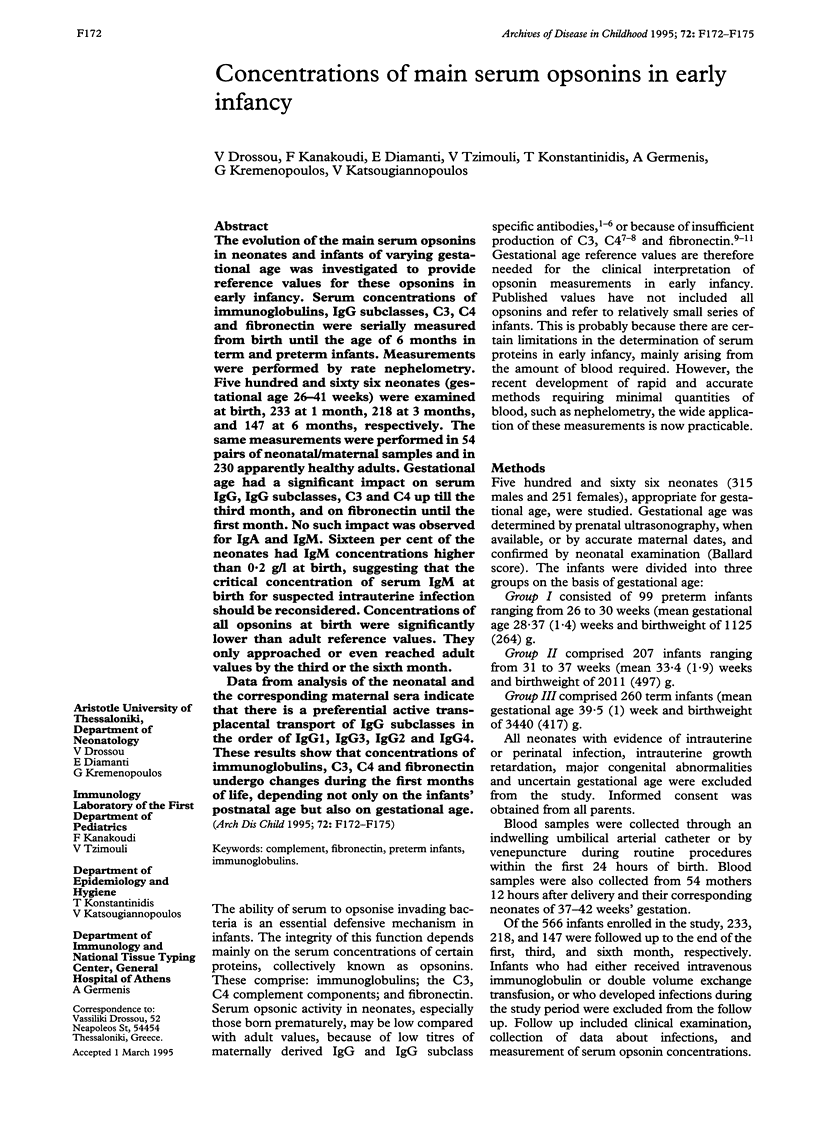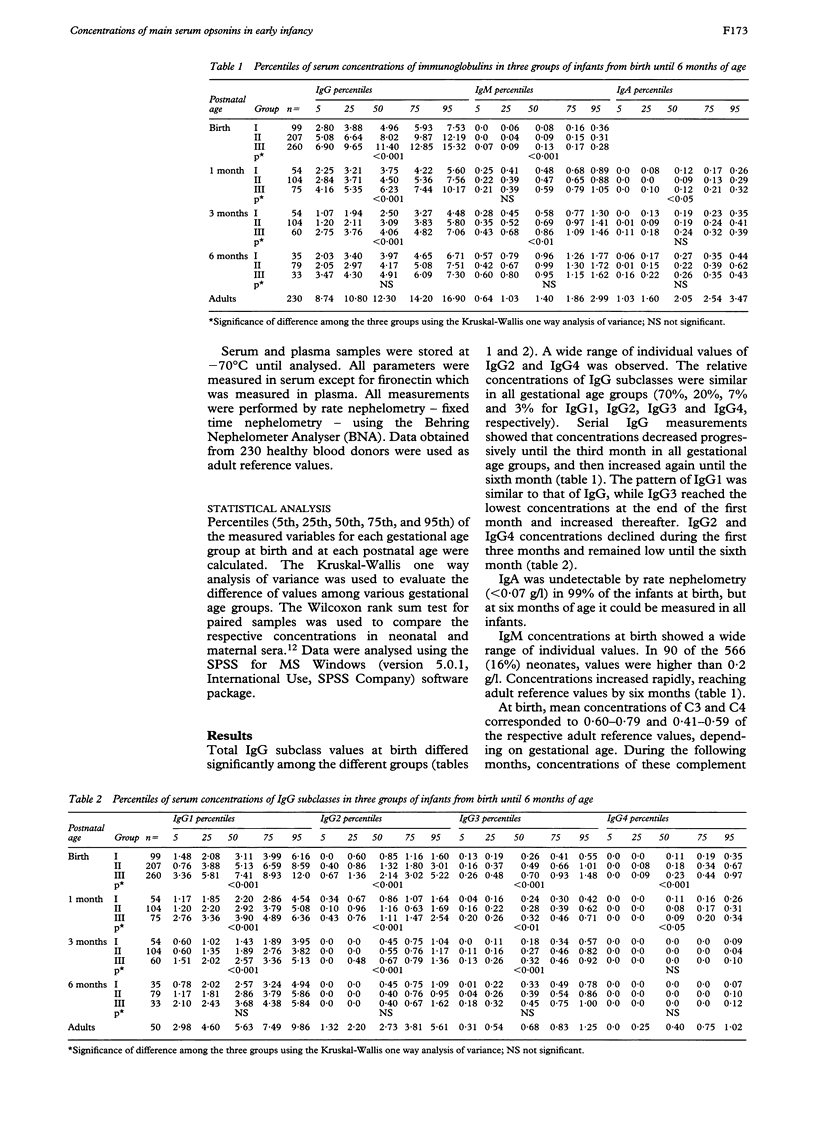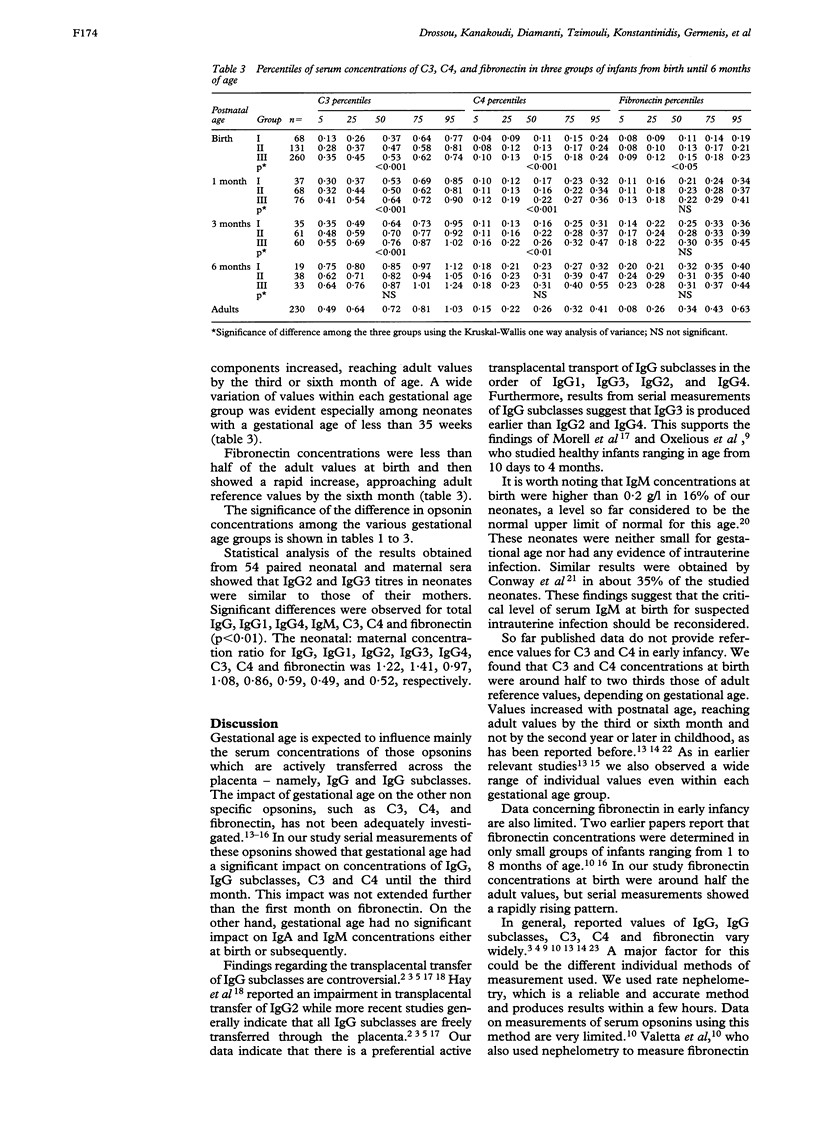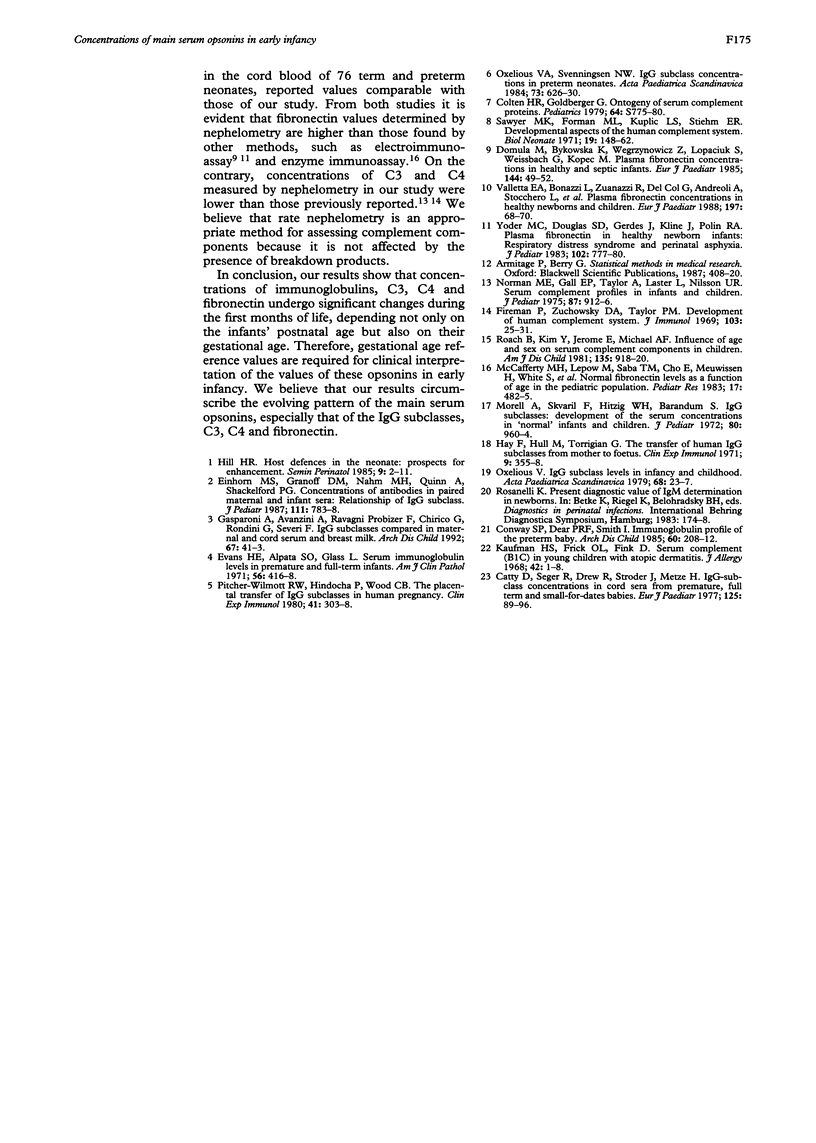Abstract
The evolution of the main serum opsonins in neonates and infants of varying gestational age was investigated to provide reference values for these opsonins in early infancy. Serum concentrations of immunoglobulins, IgG subclasses, C3, C4 and fibronectin were serially measured from birth until the age of 6 months in term and preterm infants. Measurements were performed by rate nephelometry. Five hundred and sixty six neonates (gestational age 26-41 weeks) were examined at birth, 233 at 1 month, 218 at 3 months, and 147 at 6 months, respectively. The same measurements were performed in 54 pairs of neonatal/maternal samples and in 230 apparently healthy adults. Gestational age had a significant impact on serum IgG, IgG subclasses, C3 and C4 up till the third month, and on fibronectin until the first month. No such impact was observed for IgA and IgM. Sixteen per cent of the neonates had IgM concentrations higher than 0.2 g/l at birth, suggesting that the critical concentration of serum IgM at birth for suspected intrauterine infection should be reconsidered. Concentrations of all opsonins at birth were significantly lower than adult reference values. They only approached or even reached adult values by the third or the sixth month. Data from analysis of the neonatal and the corresponding maternal sera indicate that there is a preferential active transplacental transport of IgG subclasses in the order of IgG1, IgG3, IgG2 and IgG4. These results show that concentrations of immunoglobulins, C3, C4 and fibronectin undergo changes during the first months of life, depending not only on the infants' postnatal age but also on gestational age.
Full text
PDF



Selected References
These references are in PubMed. This may not be the complete list of references from this article.
- Catty D., Seger R., Drew R., Ströder J., Metze H. IgG-subclass concentrations in cord sera from premature, full term and small-for-dates babies. Eur J Pediatr. 1977 Jun 1;125(2):89–96. doi: 10.1007/BF00489982. [DOI] [PubMed] [Google Scholar]
- Conway S. P., Dear P. R., Smith I. Immunoglobulin profile of the preterm baby. Arch Dis Child. 1985 Mar;60(3):208–212. doi: 10.1136/adc.60.3.208. [DOI] [PMC free article] [PubMed] [Google Scholar]
- Domula M., Bykowska K., Wegrzynowicz Z., Lopaciuk S., Weissbach G., Kopéc M. Plasma fibronectin concentrations in healthy and septic infants. Eur J Pediatr. 1985 May;144(1):49–52. doi: 10.1007/BF00491925. [DOI] [PubMed] [Google Scholar]
- Einhorn M. S., Granoff D. M., Nahm M. H., Quinn A., Shackelford P. G. Concentrations of antibodies in paired maternal and infant sera: relationship to IgG subclass. J Pediatr. 1987 Nov;111(5):783–788. doi: 10.1016/s0022-3476(87)80268-8. [DOI] [PubMed] [Google Scholar]
- Evans H. E., Akpata S. O., Glass L. Serum immunoglobulin levels in premature and full-term infants. Am J Clin Pathol. 1971 Sep;56(3):416–418. doi: 10.1093/ajcp/56.3.416. [DOI] [PubMed] [Google Scholar]
- Fireman P., Zuchowski D. A., Taylor P. M. Development of human complement system. J Immunol. 1969 Jul;103(1):25–31. [PubMed] [Google Scholar]
- Gasparoni A., Avanzini A., Ravagni Probizer F., Chirico G., Rondini G., Severi F. IgG subclasses compared in maternal and cord serum and breast milk. Arch Dis Child. 1992 Jan;67(1 Spec No):41–43. doi: 10.1136/adc.67.1_spec_no.41. [DOI] [PMC free article] [PubMed] [Google Scholar]
- Hay F. C., Hull M. G., Torrigiani G. The transfer of human IgG subclasses from mother to foetus. Clin Exp Immunol. 1971 Sep;9(3):355–358. [PMC free article] [PubMed] [Google Scholar]
- Hill H. R. Host defenses in the neonate: prospects for enhancement. Semin Perinatol. 1985 Jan;9(1):2–11. [PubMed] [Google Scholar]
- Kaufman H. S., Frick O. L., Fink D. Serum complement (beta 1C) in young children with atopic dermatitis. J Allergy. 1968 Jul;42(1):1–8. doi: 10.1016/0021-8707(68)90126-3. [DOI] [PubMed] [Google Scholar]
- McCafferty M. H., Lepow M., Saba T. M., Cho E., Meuwissen H., White J., Zuckerbrod S. F. Normal fibronectin levels as a function of age in the pediatric population. Pediatr Res. 1983 Jun;17(6):482–485. doi: 10.1203/00006450-198306000-00012. [DOI] [PubMed] [Google Scholar]
- Morell A., Skvaril F., Hitzig W. H., Barandun S. IgG subclasses: development of the serum concentrations in "normal" infants and children. J Pediatr. 1972 Jun;80(6):960–964. doi: 10.1016/s0022-3476(72)80007-6. [DOI] [PubMed] [Google Scholar]
- Norman M. E., Gall E. P., Taylor A., Laster L., Nilsson U. R. Serum complement profiles in infants and children. J Pediatr. 1975 Dec;87(6 Pt 1):912–916. doi: 10.1016/s0022-3476(75)80904-8. [DOI] [PubMed] [Google Scholar]
- Oxelius V. A. IgG subclass levels in infancy and childhood. Acta Paediatr Scand. 1979 Jan;68(1):23–27. doi: 10.1111/j.1651-2227.1979.tb04424.x. [DOI] [PubMed] [Google Scholar]
- Oxelius V. A., Svenningsen N. W. IgG subclass concentrations in preterm neonates. Acta Paediatr Scand. 1984 Sep;73(5):626–630. doi: 10.1111/j.1651-2227.1984.tb09986.x. [DOI] [PubMed] [Google Scholar]
- Pitcher-Wilmott R. W., Hindocha P., Wood C. B. The placental transfer of IgG subclasses in human pregnancy. Clin Exp Immunol. 1980 Aug;41(2):303–308. [PMC free article] [PubMed] [Google Scholar]
- Sawyer M. K., Forman M. L., Kuplic L. S., Stiehm E. R. Developmental aspects of the human complement system. Biol Neonate. 1971;19(1):148–162. doi: 10.1159/000240409. [DOI] [PubMed] [Google Scholar]
- Valletta E. A., Bonazzi L., Zuanazzi R., Del Col G., Andreoli A., Stocchero L., Boner A. L. Plasma fibronectin concentrations in healthy newborns and in children. Eur J Pediatr. 1988 Jan;147(1):68–70. doi: 10.1007/BF00442615. [DOI] [PubMed] [Google Scholar]
- Yoder M. C., Douglas S. D., Gerdes J., Kline J., Polin R. A. Plasma fibronectin in healthy newborn infants: respiratory distress syndrome and perinatal asphyxia. J Pediatr. 1983 May;102(5):777–780. doi: 10.1016/s0022-3476(83)80257-1. [DOI] [PubMed] [Google Scholar]


